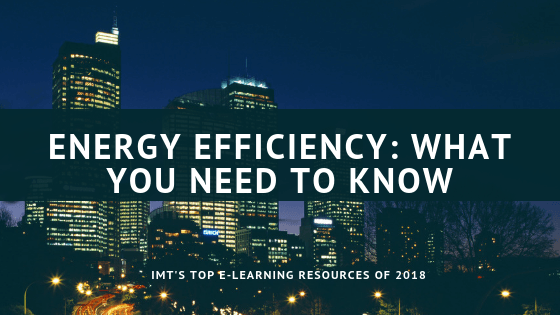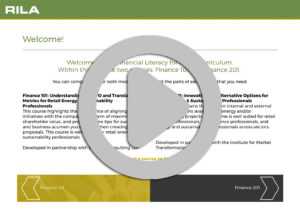
Making the Business Case for High-Performance Buildings
The Business Case for High-Performance Buildings spent several months at #1 on the U.S. Department of Energy’s Better Buildings Top 10 Solutions. Why? Because once-niche energy efficiency and sustainability concepts are evolving into high-performance standards and best practices across all building types. To stay competitive, today’s landlords, tenants, brokers, and other real estate actors need to invest in efficiency and understand the business case for doing so. This course draws from real-world examples and covers the “whys” and “hows” of incorporating green building elements into operational and investment decisions. Click below to watch.
Helping Retail Pros Knock Down Financial Barriers to Energy and Sustainability Initiatives
The Retail Industry Leaders Association’s (RILA) online e-learning courses give retail energy and sustainability managers the strategies and tools they need to navigate financial barriers that stand in the way of energy efficiency and clean energy projects getting off the ground. Originally taught as in-person workshops that were developed in collaboration with Deloitte Consulting LLC and IMT respectively, RILA’s two-part e-learning course allows professionals to self-teach, consider scenarios based on real company activities, answer test questions, and ultimately obtain a completion certificate for continuing education requirements (BOMI, GBCI). Read the brief course descriptions below and click on the images to learn more and access the online courses.
 Finance 101: Understanding the CFO and Translating Metrics for Retail Energy & Sustainability Professionals
Finance 101: Understanding the CFO and Translating Metrics for Retail Energy & Sustainability Professionals
This course explains strategies to build effective relationships with a company’s finance team that will be critical to preparing materials for leaders who make funding decisions. It also highlights key financial acumen needed to effectively communicate with the finance team throughout the project proposal process.
Finance 201: Innovative and Alternative Options for Retail Energy & Sustainability Professionals
When crafting a project proposal, it is important to consider the potential benefits of different financing options—from both internal and external sources. This course, based on IMT and RILA’s internal and external financing guides, reviews alternative financing options for energy efficiency and clean energy projects that range from internal carbon pricing and revolving loan funds to on-bill financing and PACE.
How Cities Can Put Building Energy Data to Work
Thanks to building energy benchmarking laws, more cities and counties than ever before are collecting data and deeper insights of local building stock performance. This information must be shared with building owners and other real estate stakeholders to motivate greater investments in building improvements and energy efficient practices. But what can utilities do with this information, and what areas of collaboration are there for cities and utilities? Watch IMT’s popular Putting Data to Work webinar series below to receive answers to these questions and more.
Assessing the Impacts of Benchmarking and Transparency Policies in Cities
This webinar dives into the quantifiable benefits of a citywide energy benchmarking program, the methods that city staff are using to assess the actual impacts of these policies, and some examples of how the data is being used to inform decision making.
How Cities’ Building Performance Policies Create Data Utilities Can Use
What can utilities do with building energy performance data? What areas of collaboration are there for cities and utilities? This roundtable-style discussion moderated by IMT provides energy efficiency program administrators, utilities, cities, and other efficiency stakeholders with a better understanding of key applications for using building energy data to drive efficiency improvements.
Why Efficiency Should Be a Part of Every Lease
Landlord and tenant companies representing commercial, industrial, and retail buildings can achieve billions of dollars in annual energy savings and unlock other win-win benefits with a green, high-performance lease. In 2018, IMT and the U.S. Department of Energy’s Better Buildings Alliance profiled Gold-level Green Lease Leaders for their innovative efforts to drive efficiency, clean energy, health & wellness, and smart landlord-tenant engagement strategies in their properties. Watch IMT’s webinar to hear success stories and gain insights from Kilroy Realty Corporation and JBG SMITH, receive advice on how to modernize your lease, and learn how to apply (deadline March 31st!) to become a Green Lease Leader in 2019.
Have a topic or challenge you’d like to see IMT address in our online courses and webinars in 2019? Send us a note at imtweb@imt.org.
